
Report
On the State of the Environment In China
2 0 0 2
Water Environment
 State
State
In 2002, in the seven main river basins, 29.1% of the 741 key monitored sections met the water quality standard for Grade I-III, 30.0% of the sections met Grade IV or V standards, and 40.9% of the sections was worse than Grade V standards.
Of the 199 sections in the seven main river basins under national control,
46.3% met Grade I to III standards, 26.1% met Grade IV or V, and 27.6% were
worse than Grade V. The water quality in the main streams of each river
basin was better than in the tributaries.
The pollution was severe in Liao and Hai River Basins, in which over 60% of water was worse than Grade V. The mainstream of Huai River met Grade III to V, and the water quality of its tributaries and at interfaces between provinces was more severe. The water quality in Yellow River Basin was relatively bad in general. Grade III or IV was dominant in its mainstream, while severe pollution was common in the tributaries. Grade III or IV was dominant also in Songhua River Basin. The water quality of Pearl River Basin was good in general and dominated by Grade II. The water quality of the mainstream and the immediate tributaries of the Yangtse River was good and dominated by Grade II. The order of seriousness of pollution of the seven main river basins was Hai River, Liao River, Yellow River, Huai River, Songhua River, Pearl River and Yangtse River.
The major pollution indicators were petroleum, BOD, ammonia nitrogen, permanganate index, volatile phenols and mercury.
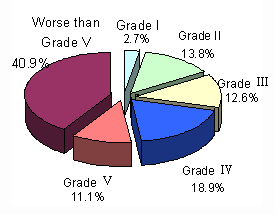
Percentage of Water Quality Grading in Seven River Basins
Main River Basins
Yangtse River Basin
A total of 128 sections were monitored,
including 39 in the mainstream. The water quality in the mainstream was
dominated by Grade II, with 2.6% of Grade I, 71.8 of Grade II, 20.5% of
Grade III and 20.5% of Grade IV.
The major pollution indicators were petroleum, ammonia nitrogen and permanganate
index.
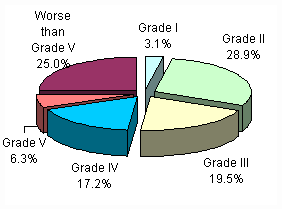
Yellow River Basin
Of the 185 monitored sections, 49.7% were
worse than Grade V. Of the 28 monitored sections along the mainstream,
3.6%, 7.0%, 35.6%, 32%, and 7.6% met the water quality standard for Grade
I, II, III, IV, V, respectively, and 14.2% were worse than Grade V. The
water quality in the mainstream was better than in the tributaries.
The water quality in Yellow River Basin was, in general, relatively poor.
The major pollution indicators were petroleum, permanganate index and
BOD.
Water Quality Grading in Yellow River Basin
Pearl River Basin
Of the 49 monitored sections, 73.5% met the
water quality standard for Grade I to III, 18.3% met the water quality
standard for Grade IV or V, and 8.2% were worse. The water quality in
Pearl River Basin was good in general.
The major pollution indicators were petroleum, permanganate index and
BOD.
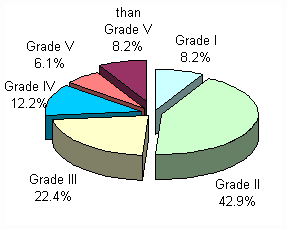
Water Quality Grading in Pearl River Basin
Songhua River Basin
Of the 101 monitored sections, 1.0%, 4.0%, 22.8%, 35.6%, 21.8% and 14.8%
met the water quality standard for Grade I through V and worse than V,
respectively.
Nenjiang River met the water quality standard for Grade III. The water
quality of the mainstream of Songhua River within Jilin Province was dominated
by Grade III, while in Heilongjiang Province, it was dominated by Grade
IV.
The major pollution indicators were volatile phenols, BOD and permanganate
index.
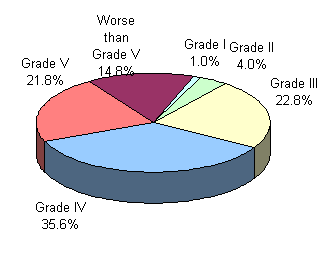
Water Quality Grading in Songhua River Basin
Huai River Basin
Of the 93 monitored sections, 16.1% met the water quality standard for
Grade II or III, 39.8% met Grade IV or V, and 44.1% were worse.
Of the 13 monitored sections in the mainstream, 38.5% met the water quality
standard for Grade I to III, 46.2% met Grade IV or V, and 15.3% were worse
than Grade V. The water quality in the immediate tributaries was dominated
by Grade IV and V. The water quality in the secondary or tertiary tributaries,
at sections across provincial boundaries and in the territory of Shangdong
Province was mainly worse than Grade V.
The major pollution indicators were ammonia nitrogen, BOD and permanganate
index.

Water Quality Grading in Huai River Basin
Hai River Basin
Of the 118 monitored sections, 14.4% met the water quality standard for
Grade III, 14.4% met Grade IV or V, and 71.2% were worse than Grade V.
The pollution in Hai River Basin was serious. The major pollution indicators
were mercury, petroleum and ammonia nitrogen.
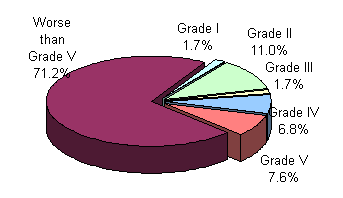
Water Quality Grading in Hai River Basin
Liao River Basin
Of the 67 monitored sections, 17.9% met the
water quality standard for Grade III, 29.9% met Grade IV or V, and 52.2%
were worse than Grade V.
The pollution in Liao River Basin was severe. The major pollution indicators
were BOD, ammonia nitrogen and volatile phenols.
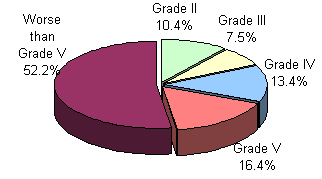
Water Quality Grading in Liao River Basin
Rivers in Zhejiang and Fujian Provinces
Of the 26 monitored sections in 14 rivers,
50.0% met the water quality standard for Grade III, 34.6% met Grade IV,
and 15.4% were worse than Grade V. No sections were found with the water
quality of Grade V. The major pollution indicators were petroleum and
dissolved oxygen. The sections severely polluted were concentrated in
Qiantang River in Hangzhou and Yongjiang River in Ningbo.
Rivers in the Southwest
The water quality was good in general. Of
the 16 monitored sections in 9 rivers, 87.5% met the water quality standard
for Grade III, 12.5% were worse than Grade V. No sections were found with
water quality of Grade IV or V. The concentration of heavy metals in water
at only 2 sections exceeded the quality standards.
In-land Rivers
The water quality of the in-land rivers was
good in general. Of the 19 sections of 7 rivers, 84.2% met the water quality
standard for Grade III and 15.8% met the standard for Grade IV or V. Major
pollution indicators were permanganate index and petroleum.
Water Quality in the Three-Gorges Reservoir Area
All of the 7 sections in the mainstream and
3 sections in the tributaries in the Three-Gorges Reservoir area met water
quality standard for Grade III. The water quality remained good. Only
the water quality in the third quarter of the year at 5 sections of Zhutuo,
Tongguanyi, Cuntan, Qingxichang and Tuokou in the mainstream exceeded
the water quality standards due to the lead contamination.
Water Quality along East Route of South-to-North Water Diversion Project
Three of the 13 monitored sections met the
targets set in the plan (Grade III water quality), accounting for 23.1%.
Two of the sections, about 15.4%, met the water quality standard for Grade
IV. Five of the sections, accounting for 38.4%, met the standard for Grade
V. The water quality at 3 sections, accounting for 23.1%, was worse than
Grade V. The major pollution indicators were BOD, ammonia nitrogen and
permanganate index.
![]()
Lakes and Reservoirs
Major lakes were severely polluted by nitrogen
and phosphorus, resulting in a predominant problem of eutrophication.
Caohai of Lake Dianchi was in a state of serious eutrophication, while
Lake Tai and Lake Chao were in a state of light eutrophication.
Tai Lake
There were 99 monitoring points, of which 20 were inside the lake, 27
were in the main rivers around the lake and 52 were in the conjunction
waters around the lake.
Of the 20 monitoring points inside the lake, 5%, 35%, 5% and 55% met the water quality standard for Grade III, IV, V or worse than Grade V, respectively. Main pollutants were total nitrogen and total phosphorus. The pollution of Wuli Lake and Meiliang Lake within the Tai Lake area were more serious than that in the center, east and west parts and the coastal area of the Lake. The assessment on eutrophication showed that the internal area of Tai Lake was in a state of light eutrophication.
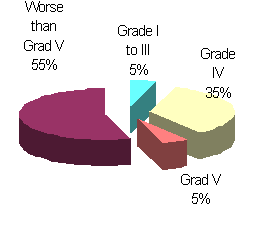
Water Quality Grading in Tai Lake
Main Pollution Indices in Tai Lake in 2002
| Area | Permanganate index(mg/L) | Total phosphorus(mg/L) | Total nitrogen(mg/L) | Chlorophylla(mg/L) | Nutrient index |
| Wuli Lake | 8.05 | 0.168 | 7.02 | 0.081 | 71.0 |
| Meiliang Lake | 6.24 | 0.154 | 4.73 | 0.042 | 66.4 |
| West bank | 5.46 | 0.097 | 2.83 | 0.032 | 62.6 |
| Lake center and east bank | 4.00 | 0.050 | 1.48 | 0.013 | 53.8 |
| Average | 4.74 | 0.079 | 2.42 | 0.023 | 59.4 |
The water pollution in the rivers around the Lake and in the conjunction areas was serious. The main pollution indicators were ammonia nitrogen, total phosphorus and BOD. Of the 79 monitoring sections for water quality, 59.5% met the Grade I to III standard for permanganate index. Considering integrated assessment of water quality, 2.5%, 3.8% and 93.7% of the monitored sections met the standards for Grade II/III, IV/V and worse than Grade V, respectively. As compared with the previous year, the water quality in rivers around the Tai Lake was degraded to some extent.
Percentage of Sections in the Rivers
around Lake Tai
with Water Quality Reaching Grade III Standard
| Monitoring indicators | Percentage of sections in rivers around the Lake meeting standard | Percentage of sections in major conjunction areas meeting standard | Percentage of sections meeting standard |
| Permanganate index | 59.3 | 59.6 | 59.5 |
| Ammonia nitrogen | 48.1 | 23.1 | 31.6 |
| Total phosphorus | 70.4 | 42.3 | 51.9 |
| Integrated assessment | 7.4 | 0 | 2.5 |
* The assessment was conducted in accordance with Grade III of “Water Quality Standards for Surface Waters GB 3838-2002”.
Dianchi Lake
The pollution in Caohai of Dianchi Lake was more serious than that in Waihai. The water quality of Waihai met Grade V standard, while in Caohai, it was worse than Grade V. As compared with the previous year, the water quality in Waihai was improved to some extent. Its permanganate index reached Grade III standard. The nitrogen and phosphorus pollution was still very serious. The nutrient indices of Caohai and Waihai were 79.0 and 60.8, respectively, with total lake average of 72.8. Lake Dianchi was in a state of serious eutrophication.
Main Pollution Indices in Lake Dianchi in 2002
| Area | Permanganate index (mg/l) | Totalphosphorus(mg/l) | Total nitrogen(mg/l) | Nutrient index | Grading |
| Caohai | 8.16 | 1.066 | 11.48 | 79.0 | Worse than V |
| Waihai | 5.64 | 0.121 | 1.94 | 60.8 | Worse than V |
| Average | 6.90 | 0.594 | 6.71 | 72.8 |
Chao Lake
The permanganate index in the lake reached the standard for Grade III, but the pollution of total nitrogen and total phosphorus was serious. At the 12 monitored points, the water quality at half of the points met the Grade V standard, while the water quality at the rest of the points was worse than Grade V. As compared with the previous year, the water quality of the Lake was improved slightly.
The pollution in the west part of the Lake was more serious than that in the east part. The west part of the Lake was in a state of moderate eutrophication, while the east part was in a moderate nutrient state. The average nutrient index of the Lake was 52.7, indicating a light eutrophication.
Main Pollution Indices in Chao Lake in 2002
| Area in Lake | Permanganate index (mg/l) | Total phosphorus(mg/l) | Total nitrogen(mg/l) | Nutrient index | Grading |
| West region | 5.55 | 0.231 | 3.22 | 61.8 | Worse than Grade V |
| East region | 4.62 | 0.116 | 1.54 | 41.9 | Worse than Grade V |
| Average | 5.09 | 0.174 | 2.38 | 52.7 | Worse than Grade V |
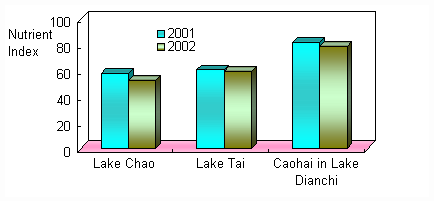
Comparison of Eutrophication in the Three Lakes
Other large lakes
Among the 8 freshwater lakes of Dongting, Dalai, Hongze, Xingkai, Nansi, Bositeng, Erhai and Jingpo, the water quality of Lake Xingkai was good and met the Grade II standard. The water quality of Lake Dongting and Lake Jingbo met the Grade IV standard. The water quality of Lake Dalai, Lake Bositeng, Lake Erhai and Lake Hongze met the Grade V standard. The pollution in Lake Nansi was relatively serious with water quality worse than Grade V standard.
Lakes inside cities
In 2002, the water quality of the lakes
inside cities was relatively poor. Except that the water quality of Kunming
Lake in Beijing met the Grade III standard, the water quality of the West
Lake in Hangzhou, the East Lake in Wuhan and the Lake Daming in Jinan
were all worse than Grade V.
Large reservoirs
Among the 10 large reservoirs, the water
quality of Miyun Reservoir, Shimen Reservoir and Qiandaohu Reservoir was
relatively good, reaching Grade III standard. The water quality of Dahuofang
Reservoir in Fushun, Yuqiao Reservoir in Tianjin, Danjiangkou Reservoir
in Hubei Province and Dongpu Reservoir in Hefei met Grade IV standard.
The water quality in Songhua Lake met Grade V standard. The pollution
in Laoshan Reservoir in Qingdao and Menlou Reservoir in Yantai was relatively
severe with water quality worse than Grade V standard.![]()
Underground Water
Of the 218 cities and regions in which
the ground water level was monitored, as compared with the previous year,
75 cities and regions witnessed the rising back of ground water levels,
accounting 34% of the total. The regions with the drop of ground water
level accounted for 50%, indicating a decrease by 12% as compared with
the previous year.
The ground water quality in most cities and regions across the country
was good in general, while some parts were polluted by point or non-point
pollution sources to some extent with some indicators exceeding the standards.
The polluted areas were mainly distributed in downtown area of the cities
in which the population density and industrialization level were relatively
high. The main indicators exceeding the standards were mineral content,
total hardness, nitrates, nitrites, ammonia nitrogen, iron, manganese,
chlorides, sulfates, fluorides and pH. The pollution of three types of
nitrogen was relatively prominent all across the country. The problem
of mineral content and hardness exceeding the standards were found mainly
in the Northeast, North China, Northwest and Southwest regions. The problems
of iron and manganese exceeding the standards were reported mainly in
Northeast and South China regions. As compared with the previous year,
the ground water quality in most cities and regions was basically stable,
or with the pollution being alleviated slightly. The ground water quality
in certain areas of some cities had a worsening trend.
![]()
Discharges of Wastewater and Major Pollutants
In 2002, the total discharge of industrial wastewater and domestic sewage across the country was 43.95 billion tons, an increase of 1.5% as compared with that in the previous year. Among the total discharge, the discharge of industrial wastewater was 20.72 billion tons, an increase of 2.3% as compared with that in the previous year; the discharge of domestic sewage from cities was 23.23 billion tons, an increase of 0.9% as compared with that in the previous year. The total COD discharge in wastewater was 13.669 million tons, decreasing by 2.7% as compared with that in the previous year. The discharge of COD in industrial wastewater was 5.84 million tons, decreasing by 3.9% as compared with that in the previous year; the discharge of COD in domestic sewage from cities was 7.829 million tons, decreasing by 1.8% as compared with that in the previous year.
Discharges of Wastewater and Major Pollutants
| Year \ Item | Wastewater
discharge (100 million tons) |
CODdischarge (10 thousand tons) |
||||
| Total | Industry | Domestic | Total | Industry | Domestic | |
| 1998 | 395.3 | 200.5 | 194.8 | 1495.6 | 800.6 | 695.0 |
| 1999 | 401.1 | 197.3 | 203.8 | 1388.9 | 691.7 | 697.2 |
| 2000 | 415.2 | 194.2 | 220.9 | 1445.0 | 704.5 | 740.5 |
| 2001 | 432.9 | 202.6 | 230.3 | 1404.8 | 607.5 | 797.3 |
| 2002 | 439.5 | 207.2 | 232.3 | 1366.9 | 584.0 | 782.9 |
| Increase/Decrease Rate(%) | 1.5 | 2.3 | 0.9 | -2.7 | -3.9 | -1.8 |
In 2002, the rate of industrial wastewater
discharge in compliance with the discharging standards was 88.3%, increasing
by 2.7% as compared with that in the previous year. The rate of wastewater
discharge from key enterprises in compliance with the discharging standards
was 89.4%, increasing by 2.5% as compared with the previous year. The
rate of wastewater discharge from other enterprises in compliance with
the discharging standards was 80.3%, increasing by 6.6% as compared with
that in the previous year.
![]()
![]() Measures and Actions
Measures and Actions
Supervision and Inspection on Tenth Five-Year-Plan for Prevention and
Control of Water Pollution in Tai Lake River Basin
SEPA and Ministry of Supervision jointly
organized the supervision departments from 12 ministries and commissions
under the State Council to conduct a comprehensive inspection on the implementation
of the plan.
Formulation of the Tenth Five-Year-Plan for Prevention and Control
of Water Pollution in Huai River, Hai River, Liao River, Lake Chao and
Dianchi Lake Area
SEPA organized a joint effort of 14 provinces, autonomous regions and
municipalities in the “Three Rivers and Three Lakes” areas to formulate
the plan based upon comments that were extensively collected from the
State Development and Planning Commission, State Economic and Trade Commission,
Ministry of Finance and Ministry of Water Resources. The plan was submitted
to and got approved by the State Council.
Ecological Water Diversion Project
In the in-land river basins of Talimu
River and Hei River, the ecological water diversion projects were kept
being implemented, which revitalized a large area of diversiform-leaved
Poplar forest in the downstream areas of Talimu River and Hei River. The
environment was obviously improved.
Water Pollution Prevention and Control in the Three-Gorges Reservoir
Area and the South-to-North Water Diversion Project
In order to implement the “Program of
Water Pollution Prevention and Ecological Conservation in the Three-Gorges
Area and Its Upper Streams” and the “Program of Water Pollution Prevention
and Control along the Central Route of South-to-North Water Diversion”,
SEPA conducted a special inspection on the clean-up of the watershed and
the prevention and control of pollution caused by vessels in the Three-Gorges
Reservoir area, and the water pollution prevention along the central route
of the South-to-North Water Diversion.
Charging for the Use of Urban Infrastructure Policy and Polluter-pays
Policy
In 2002, the Ministry of Construction,
State Development and Planning Commission and SEPA jointly promulgated
the Notice on Strengthening the Collection of Wastewater Treatment Charges
and Setting up of A Sound Operating Scheme of Urban Wastewater Discharge
and Its Centralized Treatment. The Notice on the Collection of Municipal
Sewage Treatment Charges and the Promotion of the Industrialization of
Garbage Treatment was also promulgated and implemented. ![]()